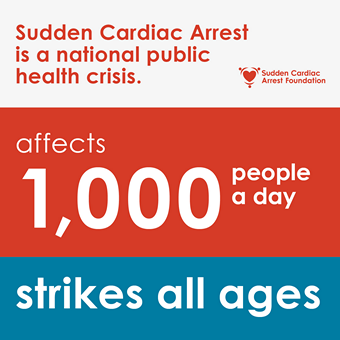You've seen them in movies, shows and books; the doctor yells "CLEAR!" and presses the metal pads on the lifeless patient, jolting them back to life. But what really is an AED, and why the heck would a regular person need one?
What is Sudden Cardiac Arrest?
Sudden Cardiac Arrest (SCA) occurs when the heart suddenly stops beating. When SCA happens, the person collapses and doesn’t respond or breathe normally. They may gasp or shake as if having a seizure. SCA leads to death in minutes if the person does not get help right away.
SCA is different from a heart attack. A heart attack occurs when part of the heart’s blood supply is reduced or blocked, causing the heart muscle to become injured or die. During a heart attack, the victim's heart is still beating. They are still conscious and breathing.
Sudden Cardiac Arrest can happen to anyone, anywhere, with no warning signs.
While age, health, and genetics can be risk factors, they are not necessary for someone to experience SCA. According to the Sudden Cardiac Arrest Foundation, "cardiac arrest remains a public health crisis. There are more than 356,000 out-of-hospital cardiac arrests (OHCA) annually in the U.S., nearly 90% of them fatal. The incidence of EMS-assessed non-traumatic OHCA in people of any age is estimated to be 356,461, or nearly 1,000 people each day." If this doesn't alarm you, it should. SCA is a public health risk to people of all ages and backgrounds. But the good news is, it has an effective treatment.
more than 356,000 out-of-hospital cardiac arrests (OHCA) annually in the U.S., nearly 90% of them fatal. The incidence of EMS-assessed non-traumatic OHCA in people of any age is estimated to be 356,461, or nearly 1,000 people each day." If this doesn't alarm you, it should. SCA is a public health risk to people of all ages and backgrounds. But the good news is, it has an effective treatment.
How do AEDs Work?
Automated External Defibrillators (AED's) work by delivering a shock to a victim's heart in an attempt to "restart" it and get it back into a normal rhythm. While this may sound scary, AED's have been used for decades and are extremely safe and effective. According to just one study, "Cardiac arrest victims who received a shock from a publicly-available AED that was administered by a bystander had 2.62 times higher odds of survival to hospital discharge and 2.73 times more favorable outcomes for functioning compared to victims who first received an AED shock after emergency responders arrived." That's right, it said AED's administered by a bystander. Anyone capable of following instructions is capable of using an AED. Upon opening, it will provide detailed instructions for its use. They are designed to be as easy to use as possible. Next time you're out and about, look around for a cabinet labeled "AED", they're everywhere.
So, if they're everywhere, why do you need one for yourself?
The answer is simple. The second you leave a public space you immediately put yourself at risk. In fact, up to 73.9% of cardiac arrests occur in the home. That means if you were to have a cardiac arrest, three out of four times it would be where an AED is not present (assuming you don't have one). You, and you alone, have the power to change that. You have the power to put a lifesaving device in your place of residence, business, church, or anywhere else you may want one. You have the power to save a life, and all it takes is the purchase and deployment of an AED. How cool is that?

